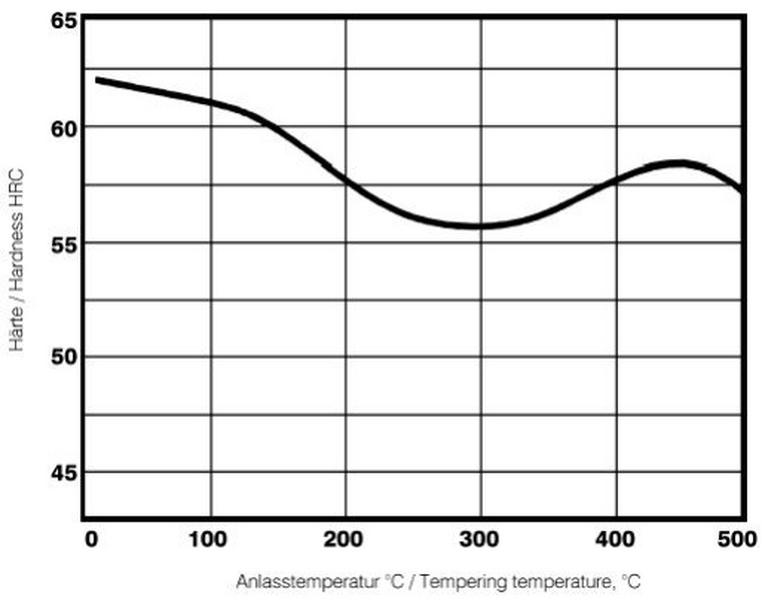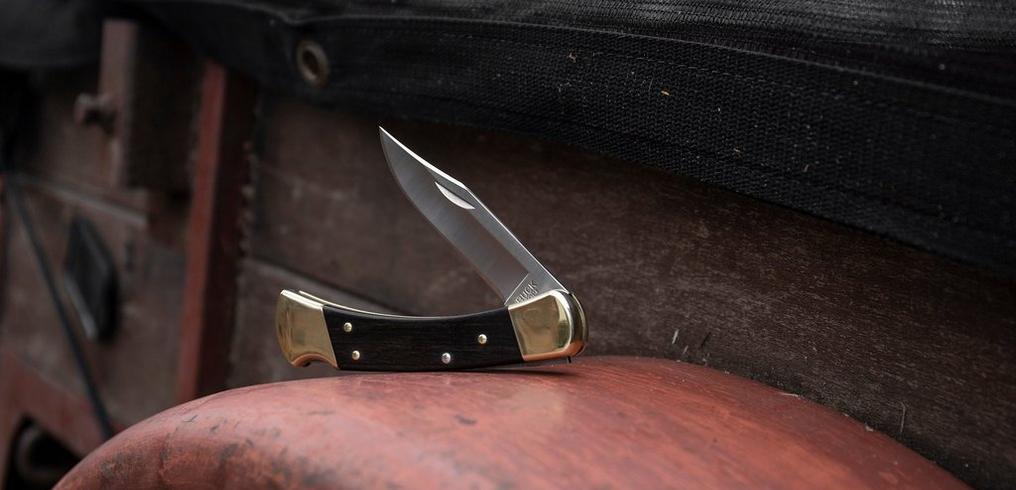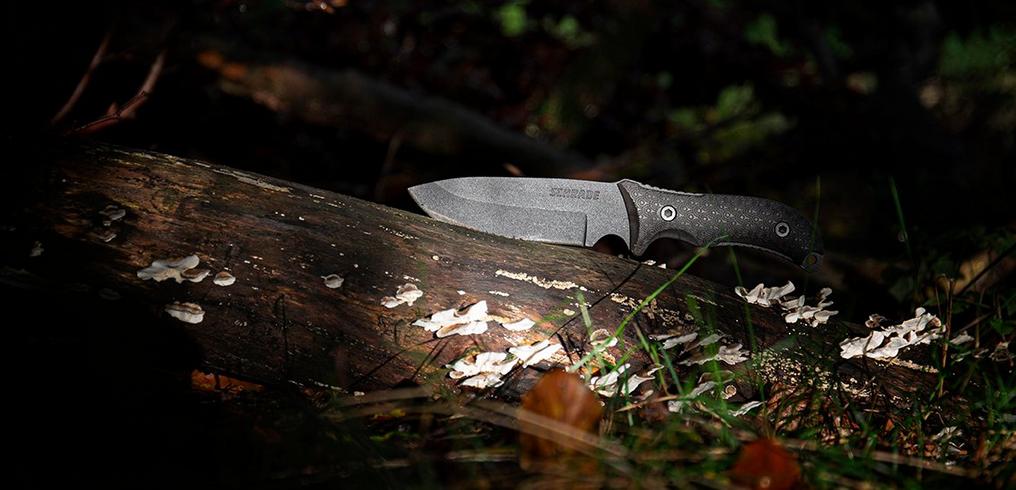What does hardness tell you about a knife?
There are many misconceptions about what the hardness of a knife means in regards to its properties. That's why we would love to explain what you can and cannot deduce from the hardness of a knife.
What do people generally think about hardness?
We often hear from our customers, but also read online on various forums, that a knife with a higher hardness retains its sharpness longer than one with a lower hardness. And that a knife with a lower hardness breaks less easily than one with a higher hardness. That enormous differences can be noticed at two points difference in hardness. This may all be true, but is by no means self-evident and not true in all cases. In fact, there are many other factors that determine the specific properties of a knife other than just its hardness.
How we measure hardness: the Rockwell C scale
Let's start at the beginning: how do we measure hardness? The hardness of steel is often specified according to the Rockwell C hardness scale. This is a test method in which a diamond cone with a calibrated weight of ten kilos is loaded onto the specimen, after which the weight is increased to 150 kilos. The difference between the first and the second weight is used to determine the Rockwell C hardness. The deeper the diamond penetrates the steel, the lower the hardness. Makes sense.
The C stands for Conus, for softer metals you can also use a ball. That's when we talk about the hardness on the Rockwell B-scale, where B stands for Ball. For hardened steel we always talk about the Rockwell C scale. HRC in short.
Many manufacturers list that hardness as a range of 2-3 points. So a knife is hardened up to 56-58HRC. This means that the hardness lies somewhere in between. Usually 57, sometimes a little above or below. The maximum deviations are listed in the ISO certificates of the industrial hardening plants knife manufacturers use for this purpose. A difference of two points seems like a lot between 56 and 58, but is, on a total scale from 0 to 100, not that substantial. That is how you need to look at it as well.
A difference in hardness from 56 to 58 could be the result of the place in the oven that the blade was left to harden. Or even within one workpiece: if you measure a knife in multiple places you will always find slight deviations between the different measuring points. For a good Rockwell test we recommend always testing at least three times, and list the average of the three tests.
How does a knife end up with its hardness?
To give a knife its hardness it needs to be, yes, hardened. Simply put: the knife is heated up to a specific, high temperature. From 800 to 1200 degrees, varying per steel type and recipe. Afterwards the blade is quickly cooled back down. In oil or water, in between thick aluminium sheets, or simply in the cold air. Afterwards the blade will be rock-solid. A little like a file: hard, but brittle. After that it needs to be tempered. The knife is heated to a temperature of 150-300 degrees, once again depending on the type and recipe, one or multiple times for an x amount of hours to bring the hardness back to a perfect level.
We said it before: this is a simplified view. After all, there could be twenty different heat treatment recipes for only one type of steel which, each in their own way, will bring forward the best in the steel. And of those twenty there could be three that reach a hardness of 60-61, but still leave you with different features in the steel.
There is more than just hardness alone
It is important to know that the hardness does not determine everything for a type of steel. It is only one of many qualities. And because it can be captured in a simple numeric value, it is a popular choice when it comes to comparisons. It is, after all, easier to compare the numeric value '57HRC' with '61HRC', than the size, the density and the components of individual molecules and carbides in the steel.
Now we get a little technical, but it is important to understand the heart of the story. We will try to make it as clear as possible.
When you put a piece of steel underneath a microscope you can see that it is comprised of different components. Simply put: the steel contains carbides. These are a type of hard pebbles. These carbides are held together in a certain structure. Like bricks are cemented together to create one wall.
By heating up the steel at a certain temperature, for a specific period of time, the steel will rearrange itself at a microscopic level. The carbides and the connections between the carbides (the cement) change. Harder or softer, broader or thinner. In theory it is possible to harden the same type of steel with two different recipes and end up with the same hardness. While for cement some samples are softer and take up more room, while others are tightly packed together. The number from the Rockwell hardness tester, however, doesn't say anything about this. But you can imagine that a wall with such broad, soft mortars is more likely to topple than a tightly bricked wall with firm mortars.
This can also affect the sharpness retention, the toughness and the corrosion resistance. You can't tell when you look at the number '61HRC'. The following graph comes from that data sheet (a type of manual) for Böhler N690 steel. On the vertical axis you see the Rockwell C hardness, and on the horizontal axis the temper temperature you need to maintain for it.
When you look closely you can see that in three different places the rockwell hardness is 58. Does the steel have the same quality in all three places because it is at 58 HRC? Not by a long shot. For one of these points the steel is more corrosion resistant than for the other. There is also a point where the steel is more wear and tear resistant. You won't see this difference when you look at the HRC value alone.
As said before, there is a lot to be said against the above, but it is an example that demonstrates that there is more to such an HRC number as you might think.
Structure of the steel vs the hardness
We talked about the hardness before, and the construction of the steel. The example of the wall was already quite clear, but we will take it one step further. We will go from 2D (a wall) to 3D (a large, solid, brick block).
Because for several decades now, types of steel are not only made by throwing different alloy elements in a large melting pot, and stirring it a couple times. Today there are also types of 'powder steel'. These are types of steel for which the different alloying elements are pulverised and mixed. This leaves you with a much finer structure. Now we are no longer talking about bricks, but pebbles. Which are tighter together, with thin layers of cement in between. Does anything break? Then it's not the entire brick coming off, but just a small pebble. Much stronger. Examples of this are CPM types of steel from Crucible, such as S30V, S35VN and all other types of steel that start with CPM. For Carpenter, they are MicroMelt (MM) steels. Like CTS-XHP and CTS-204P. For Böhler, for instance, we are talking about the famous Böhler M390, which is made according to their MicroClean process.
Because of that finer structure on a molecular level these types of powder steels are better capable of retaining their sharpness, and because of the finer structure they are also less prone to break.
So, building on this, it could very well be that a simple type of steel with a coarse structure and a hardness of 61HRC is less capable of retaining its sharpness, than a powder steel with a hardness of 58HRC. Simply because it is much more difficult to break off a small pebble than a large brick.
Additional finishing touches during the heat treatment
In the above-mentioned simplified explanation of a heat treatment we didn't talk about the different nuances that can be applied as a blade is hardened or tempered. A cryogenic treatment in liquid nitrogen, for instance, can leave you with better qualities, without it necessarily being reflected in the hardness. Simply because at a molecular level, it improves things even more. And will you leave the knife in the liquid nitrogen for one, two or perhaps even twelve hours? All differences you can't really see. M390, for instance, can, with a cryogenic treatment at 59HRC retain its sharpness better than M390 which, at 61HRC, did not get such a treatment.
BOS Heat Treatment
A famous example are the heat treatment recipes from Paul Bos, which have been used by Buck Knives for years now. When you look at the blade or packaging you will find a little logo with flames and 'BOS'. Some enthusiasts sometimes say that they prefer 420HC (a relatively simple type of steel) that has undergone a Paul Bos heat treatment, than the famous powder metallurgical CPM S30V which was hardened by someone else. Does it show when you look at the Rockwell hardness? No.
Sharpness retention: hardness vs sharpening angle
The fact that sharpness retention cannot be directly linked to hardness was proven by Dr. Larrin Thomas from KnifeSteelNerds. He tested prepared pieces of CPM 154 steel with the exact same hardness and had them sharpened at different sharpening angles. The test results showed that there were quite substantial differences in sharpness retention. And the blade had the same hardness. This proves that comparing sharpness retention in knives made from the same type of steel, from different manufacturers and with different shapes and geometries is actually impossible. Comparing apples and pears. By the way, we can really recommend the KnifeSteelNerds website if you are looking for more scientific information about knife steel. Larrin Thomas also wrote an interesting and complete book about this topic.
So what does the hardness say?
The measured hardness mostly means something for the manufacturer. He/she can tell whether the recipe with the planned hardness was actually achieved. If, for instance, you aim for a hardness of 60-61HRC, and the steel is 56-57HRC or even 64-65HRC something went wrong while executing the recipe.
In the basis this is the only conclusion you can draw from an HRC score. Of course: the same type of steel that leaves you with 55HRC for one manufacturer, and for the other with an extreme 65HRC: you could say something about it. But within the reasonable range of 58-62HRC you can't say a lot about the sharpness retention of steel purely based on the HRC score.
Finally
The heat treatment of steel is and remains a difficult topic. It is for a reason that every year people graduate in metallurgy. Therefore, we do not claim to know all about the topic at hand. But we do hope that this topic will shine some light on the subject, outside the usual forum and social media discussions. There is more than that single HRC number, and the fact that 95% of the manufacturers hardens a type of steel on HRC X, doesn't mean that the remaining 5% is doing something wrong.



?%24center=center&%24poi=poi&%24product-image%24=&fmt=auto&h=490&poi=%7B%24this.metadata.pointOfInterest.x%7D%2C%7B%24this.metadata.pointOfInterest.y%7D%2C%7B%24this.metadata.pointOfInterest.w%7D%2C%7B%24this.metadata.pointOfInterest.h%7D&scaleFit=%7B%28%24this.metadata.pointOfInterest%29%3F%24poi%3A%24center%7D&sm=c&w=1016)




